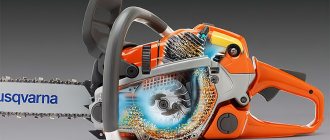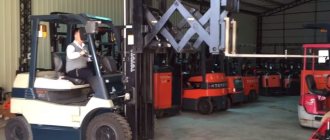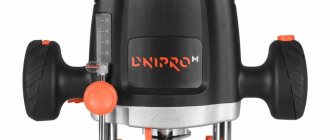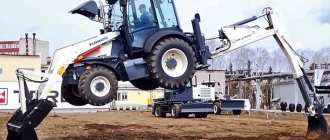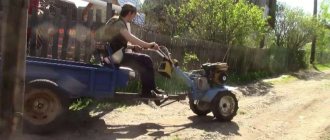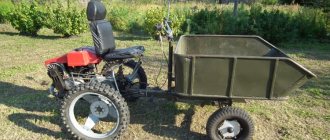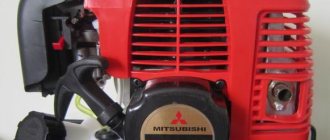Successful landscaping requires a lot of effort. To reduce the burden on people, manufacturers of special equipment are developing devices that completely take over labor-intensive operations.
If an excavator is used for work in deep layers of soil, then for surface treatment it is sufficient to use a trencher.
This is a compact device that is capable of laying a trench in any, even the most cramped conditions. Depending on the modification, the depth of the ditch is up to 120 cm.
What is a trench?
The majority of all communications associated with the laying of cables for various purposes, pipelines, gas pipelines and other similar structures are laid in trenches. A trench is an open excavation of soil of a longitudinal shape of a certain depth, ranging from several meters to many kilometers in length. According to the cross-section of the trench profile, there are rectangular, trapezoidal and mixed.
1. Rectangular trenches have strictly vertical walls, which in loose soils must be strengthened to prevent collapse.
Reference! The walls do not need to be strengthened if the trench is being dug in soils with natural moisture and there is no groundwater in it.
Maximum trench depth without strengthening the walls:
- Sandy and bulk soils – 1 meter
- Sandy loam soils and loams – 1.2 – 1.5 meters
- Clay soils – 1.5 meters
2. Trapezoidal trenches require excavation of a large amount of soil. In the city this is the least practical, but the advantage of such a trench is that it is protected from collapse. When the soil is dug manually, the main profile is trapezoidal, in order to avoid injury to workers when the walls of the trench collapse.
3. The mixed type of trenches is used in the presence of groundwater located above the level of laying communications.
Areas of application
Trenchers are machines that have a wide range of options, which allows them to be used in various fields, namely:
- arrangement of open pits for laying utilities;
- formation of trenches for laying the construction base;
- digging ditches to install drainage systems in areas with high humidity;
- loosening the soil for further planting of various plants;
- dismantling the road surface for the purpose of laying a new road surface, repairing or installing utilities;
- cutting individual elements from sandstone and other similar materials;
- excavation of a tree along with an impressive lump of earth for replanting the plant in another place.
This technique is also used when performing other types of excavation work. The machine can be used for any type of soil and at any time of the year.
Methods for digging trenches
1. Manual
The least productive method is used when:
- there is no possibility to adjust the equipment;
- There are other communications located next to the trench;
- other obstacles, incl. financial, which do not allow the use of special equipment.
2. Excavator
Excavators efficiently dig straight, trapezoidal, and mixed trenches.
However, there are also limitations here, both in terms of the minimum trench width, which depends on the width of the handle, and productivity, which depends on the volume of the bucket.
Trench width and bucket volume:
- backhoe loaders – 300mm (0.07 liters)
- mini excavators from 1.2 t – 250 mm (0.023 liters)
- mini excavators up to 1.2 t – 200mm (0.012 liters)
3. Chain excavator (bara)
The chain excavator is designed for productive trenching with a rectangular profile. It is most effective on heavy soils - limestone, permafrost, concrete, dense loam and clay of any density.
It is advisable to use bars under the following conditions:
- Trench depth – up to 2 meters
- Trench width – 250-400 mm
- The soil is complex and heavy
It is inappropriate or ambiguous to use bara when:
- dense building of the facility;
- the need to dig a trench close to obstacles, for example, the foundation of a building or a fence;
- trench width 200 mm or less, with the exception of narrow-profile companies.
4.Mounted hydraulic trencher
A mounted trencher is suitable if:
- it is necessary to lay cables, narrow pipelines for various purposes, drainage drains, which are sufficiently 150-250 mm wide;
- trench depth - 900, 1200 or 1500 mm;
- digging a trench is part of the proposed work;
- your machine is a skid steer, backhoe loader or mini excavator 5-11 tons
Types of cars
There are several types of machines, depending on their design features.
Chain
This type of technology is in demand among users. The working body of this machine has the following device:
- Frame - is a rectangular frame made of high-strength metal, which imparts rigidity to the structure;
- Sprockets - tension and wire, the first of which is located at the end of the bus and provides chain tension, and the second is on the shaft of the reduction gear and it activates the chain;
- A chain is an element located in one or two rows, consisting of several links into which cutters or scrapers are inserted.
- Side auger - an element designed to remove soil that the chain digs up;
- Shoe is an element that is located on the tire of the working mechanism and is responsible for cleaning the chain from adhering soil;
- Reduction gear – activates the chain;
- A single hydraulic cylinder is an element designed to adjust the dimensions of the pit and to raise the working device to a safe position.
Chain trenchers are recommended for use in constructing trenches 0.15 m wide and up to 5-6 m deep.
Rotary
This is a technique with a wide range of applications. The equipment design is as follows:
- Frame – an element on which the working part and other devices are fixed;
- Rotor – a disk on which working cutting mechanisms are placed;
- Protective casing – protects the control cabin from stones and rocks flying out from under the rotor during operation of the mechanism;
- Hydrostatic drive – a device that drives the rotor;
- Hydraulic cylinders are mechanisms that help deepen the working part of the equipment;
- The rear support wheel is a device for setting the required digging depth and for transporting equipment along the roadway.
Rotary-type equipment is recommended to be used to create wide channels up to 2.5 meters, the depth of which reaches 3 meters. The main advantage is high performance.
Flaws:
- large dimensions, which makes it difficult to deliver equipment to the digging site;
- high cost of work.
Tracked
Such equipment is installed on crawler tractors. The machines are equipped with a rotary or chain type working body.
Advantages:
- high cross-country ability;
- good degree of adhesion to the soil;
- high motor power;
- the possibility of positioning the frame and working body in different positions;
- Possibility of using equipment on hilly terrain.
Flaws:
- cannot be moved over long distances without using a special carriage.
Manual
This is a convenient tool that is small in size. The device is recommended for use in summer cottages and private houses. Simple models consist of a gasoline engine and a chain working element.
There are also models characterized by high power and performance. Such devices are attachments to walk-behind tractors, walk-behind cultivators and self-propelled units.
The manual device is recommended for use in the construction of narrow shallow channels up to 1 meter.
What is a mounted hydraulic trencher?
A hydraulic mounted trencher is a type of earth-moving equipment in the form of attachments that is mounted on a base machine and operates from its hydraulics.
English Delta trenchers are used as attachments for mini-loaders, excavators and backhoe loaders weighing from 3 to 11 tons.
GC "Tradition" offers 3 models of trenchers - TR 900, TR 1200 and TR 1500. The marking indicates the maximum depth that a specific trencher model can dig.
Features of using trench excavators
It is believed that in general the productivity of trench excavators on loose and cohesive soils is not very high. If you nevertheless decide to resort to using this type of equipment for digging trenches in gravel or sand, then it makes sense to use a model of a larger size than required by calculations. By digging a trench of greater width and depth, you can compensate for soil collapse.
Photo source: beldem.ru Tractor-based trencher
Unlike excavators, in cases where it becomes necessary to secure the formwork, you will have to resort to outside help.
During work operations, it is recommended to keep the working body of the trencher at an angle of 45-60 degrees: with such values, maximum productivity is achieved. The depth of the trench being dug can be adjusted both by changing the angle of inclination of the bar and by adjusting the position of the support slide.
A few more recommendations: the optimal option is to operate the machine at 75% of full power and 90% of peak torque.
Trencher design
The housing houses a gearbox driven by a hydraulic motor, essentially a horizontal hydraulic rotator. A drive sprocket and a screw soil drain are installed on the gearbox shaft.
On the body:
- a metal runner (“ski”) is fixed;
- an adapter is attached that connects to the base machine;
- the protective casing is fixed;
- a protective pipe with a scraper was installed for final cleaning of the trench;
- The trencher's boom is fixed along which a chain moves, cutting the soil.
The chain is metal, equipped with teeth of different types.
Device models and manufacturers
Today, the special equipment market offers a large number of manufacturers, models and varieties of trenchers.
Among them there are a number of particularly popular modifications, equipped with components necessary for effective operation. However, they have significant differences.
Barreto 912
The device is powered by a 9 HP motor. With. It is capable of forming a trench 30 cm deep. The boom and chains used for digging are of hydraulic design.
In addition, the model is equipped with overrunning clutches located on the sides of the body . The joint bushings are protected from clogging using a specially developed system.
The advantages include significantly reduced weight and compactness compared to analogues, which makes it possible to work in tight spaces.
Kwik-Trench Earth Saw
The model of this brand is characterized by the ability to form narrow trenches for cables, pipes or channels for installing curbs.
In this case, the extracted soil is dumped to the side, which greatly simplifies the work. The depth of the dug hole is 30 cm.
Vermeer RT60
This manufacturer offers the buyer a choice of models equipped with two different engines. This could be a 6 hp Kohler power plant. With. or Honda - 5.5 l. With.
The ditch digger is characterized by compact dimensions and is designed for digging holes for irrigation systems, telephone cables and other similar work . The advantages of this model include:
- an arrow that is lowered into a trench;
- special transmission design , which is controlled using a foot pedal,
- loading handles for easy movement of the device.
The car weighs 122 kg.
Ground Hog T-4 Trencher
The manual trencher of this brand is equipped with a chain-type cutting device. The main purpose is the accelerated formation of trenches.
The result is ditches with smooth edges 30 cm deep and 7.5 cm wide. The immersion depth can be varied by 15, 20 and 30 cm depending on the model.
Attention! Before making a purchase, it is necessary to determine the scope of work and the workload for a manual trencher.
The advantages of the device include the presence of both standard and carbide teeth, which are used on rocky soil.
In addition, the design provides supports for conical rollers. The body is protected from corrosion by powder coating. The manufacturer has provided its products with simplified maintenance.
Bluebird Bed Bug
This brand offers two varieties that are created for specific tasks. Landscape Edger prepares the base of flower beds and helps with landscaping.
Another variety, Cable Layer, was created specifically for forming trenches for cables, pipes and other similar purposes. The device can also fill the soil back, burying the laid networks.
The models differ from each other in the presence of replaceable blades. The devices have a common base. The casing on the device is replaceable. If necessary, it can be easily dismantled and access to the internal parts of the device.
To carry out minor repairs or maintenance of the Bluebird Bed Bug trencher, you do not need to have special knowledge and skills, or use additional tools.
The model is equipped with a Honda GX 5.5 liter power plant. With. This power provides the necessary trenching speed and high productivity.
Small-sized manual trencher TKMG-1200
Among domestic units, the manual trencher TKMG-1200 deserves special attention. This is a hydraulic model characterized by compact dimensions.
– uses the Japanese model Robin Engines, which runs on gasoline, as a power unit. The advantages of such a device:
- high reliability of components and wear resistance of the housing;
- the speed of rotation of the cutting body is controlled smoothly by a stepless system;
- the model is significantly cheaper compared to foreign analogues of the same power;
- the device does not require obtaining permits from the relevant authorities.
The weight of the device is 600 kg. Travel speed in transport mode is 4 km/h. The depth of the dug channel is 120 cm.
Ditch Witch
The line of models produced under this brand includes:
- RT12;
- RT16;
- RT20;
- RT24.
All of them are characterized by:
- hydraulic drive system;
- basic operation and maintenance;
- high quality materials for production and components;
- optimal ratio of cost and quality characteristics;
- reliable protection of structural components;
- the ability to move both on wheels and on tracks.
The models are equipped with a Honda GX690 engine. Movement is carried out at the expense of one forward speed and one rear.
How does a mounted hydraulic trencher work?
Mini loaders
The trencher is mounted on a mini loader via an adapter mounting frame. The convenience of digging trenches with a mini-loader is that, thanks to the torque converter transmission, it can simultaneously drive and work as a trencher.
Backhoe loaders
The trencher is installed on a backhoe loader via an adapter suspension (like a hydraulic hammer). First, the machine stops at the beginning of the future trench and is fixed with outriggers, then it extends the boom with the trencher to its full length and digs a trench, pulling the trencher by working with the boom and handle. Then he moves further, fixes himself and digs a trench, working with an arrow. These movements are repeated along the entire length of the trench.
You can read more about the operation of the trencher here.
Rating of the best manufacturers
Both domestic and foreign companies are engaged in the production of trenchers. Below are the best ones.
Caterpillar
This is an American company that is popular all over the world. It produces various types of special equipment, including trenchers. Machines from this manufacturer are recommended for use in construction, agriculture, etc. The equipment is suitable for constructing shallow trenches for laying utility lines.
Vermeer Manufacturing Company
This is another popular American company. It represents several lines of trenchers of different types.
Expert opinion
Kurdin Sergey Sergeevich
The manufacturer's equipment is equipped with electronic control using a microprocessor system. It synchronizes the operation of the tractor and the working part of the equipment. This process not only simplifies the operation of the machine, but also allows you to quickly detect a malfunction if it occurs.
Case Corporation
This is a French company engaged in the production of trenchers. This equipment is made of high-quality materials and is distinguished by high-quality assembly. However, it does not have very high productivity, which is the main drawback of the technology.
Raditsky Machine-Building Plant LLC
This is a Russian Bryansk manufacturer that produces rotary trenchers based on tracked tractors. These are large-sized machines, the use of which is recommended for constructing wide and deep ditches.
DSUE "Dmitrov Excavator Plant"
The manufacturer produces chain-type equipment. The machines are highly productive. The equipment can be used at any time of the year, since it is equipped with several types of chains, including for frozen ground.
JSC "Mikhnevsky Mechanical Repair Plant"
The manufacturer offers users chain-type equipment for use at any time of the year. The plant's equipment is of high quality and productivity. In addition, the machines have a long operating period without any malfunctions.
OJSC "Kopeysk Machine-Building Plant"
This is a Chelyabinsk manufacturer that produces chain and bar-type mining machines. The equipment is recommended for use on frozen soils. The equipment is distinguished by high quality, ease of use and a long service life.
Trencher performance
| Capacity m/min | |||
| Width/Model | Delta TR900 | Delta TR1200 | Delta TR1500 |
| 100 combi (category I - III) | 1,2 | — | — |
| 150 combi (category I - III) | 1 | 1 | 0,9 |
| 200 combi (category I - II) | 0,8 | 0,8 | 0,7 |
| 250 combi (category I) | 0,4 | 0,3 | — |
| 100 tungsten (category II - IV) | 1 | — | — |
| 150 tungsten (category II - III) | 0,8 | 0,7 | 0,6 |
| 200 tungsten (category II) | 0,7 | 0,6 | 0,5 |
Characteristics and applicability of Delta trenchers
| Characteristics and applicability of Delta trenchers | |||||
| Basic car | Flow, l/min | Maud. trench digger | Trench width | Chain type | Trench depth |
| Skid steer (without Hi-FLow) | 45-80 | Delta TR 900 | 100, 150, 200 | Combi | 600 / 750 / 900 |
| 100, 150 | Tungsten | ||||
| Mini Loader(with Hi-FLow) | 70-115 | Delta TR 900 | 100, 150, 200, 250 | Combi | 600 / 750 / 900 |
| 100, 150, 200, 250 | Tungsten | ||||
| Delta TR 1200 | 150 | Combi | 800 / 1000 / 1200 | ||
| Backhoe loaders | 80-115 | Delta TR 1200 | 150, 200, 250 | Combi | 800 / 1000 / 1200 |
| 150, 200 | Tungsten | ||||
| Delta TR 1500 | 150, 200 | Combi | 1000 / 1250 / 1500 | ||
| Tungsten | |||||
Types of trencher chains
The “combi” chain has teeth with tungsten inserts - they cut soil of categories I-III with an admixture of stones of no more than 20%, as well as teeth for soft soil, which, thanks to their bucket-shaped shape, act as a soil transporter to the surface of the trench. The average productivity of equipment with a combined chain is 1 meter per minute.
Looking for a trencher? Our specialists will always help you with your choice.
Choose a trencher
If it is low, it is necessary to replace the earthen teeth with rock ones (or reduce their number) - this is how we get a “tungsten” chain that overcomes permafrost, ice, reinforced road surfaces and soil containing up to 30% construction waste and stones.
PR rock chains are experimental, but have already shown that they take stronger soil than tungsten chains.
Equipment selection rules
When choosing a technique, it is recommended to focus on the following points:
- Soil type.
- Dimensions of the trench to be dug.
- The size of the area where the work will be carried out, as well as the size of the equipment.
- Machine performance - it is best to choose models with the highest performance, as they will help you finish the job quickly.
Advantages of mounted hydraulic trenchers
- Mechanized labor - stable workload;
- Speed of laying communications - smooth walls, no obstacles during laying;
- High backfill speed
- Convenient backfilling - no need to break up large clods of soil;
- Mobility - delivery of equipment to any place without the use of special equipment;
- Maneuverability - work in confined spaces;
- Various Depths - Each Delta TR can dig trenches at three different depths;
- Chains of different types - the ability to make trenches in soils of any density;
- Long service life - thanks to simplicity of design and regular maintenance;
- Safety - all moving parts are protected from human contact;
- Versatility - the trencher expands the capabilities of the equipment, increasing your profits;
- Savings - the minimum volume of selected soil saves machine fuel and time for backfilling;
- Benefit - a mounted trencher is cheaper than specialized equipment.
Advantages and disadvantages
Trenchers have the following advantages:
- high speed;
- a large number of additional options;
- can be used for any type of soil thanks to the powerful working body;
- the possibility of arranging canals at any time of the year;
- ease of use;
- reducing the likelihood of soil collapse, since the edges of the ditch are smooth;
- reducing the cost of transporting soil;
- possibility of digging channels of various sizes;
- can be used in any weather at any time of the year.
In addition, if the equipment is used on the roadway, the area of destruction of the coating is reduced.
Flaws:
- high cost of equipment;
- Some types of equipment require additional equipment for transportation.

